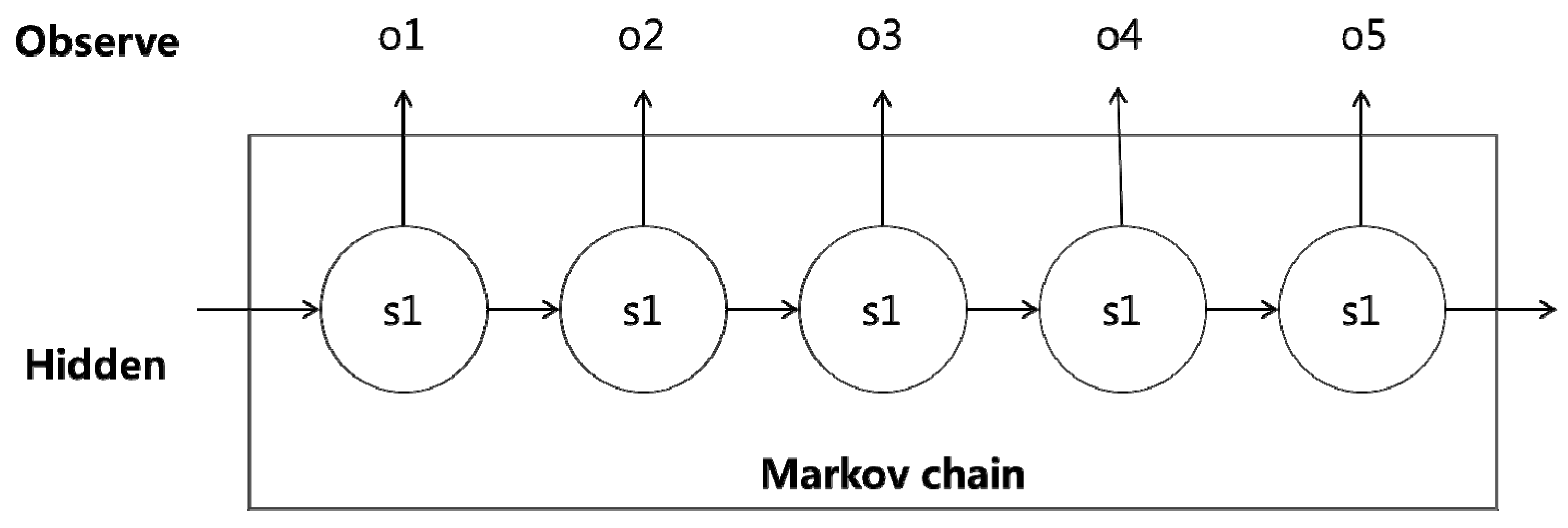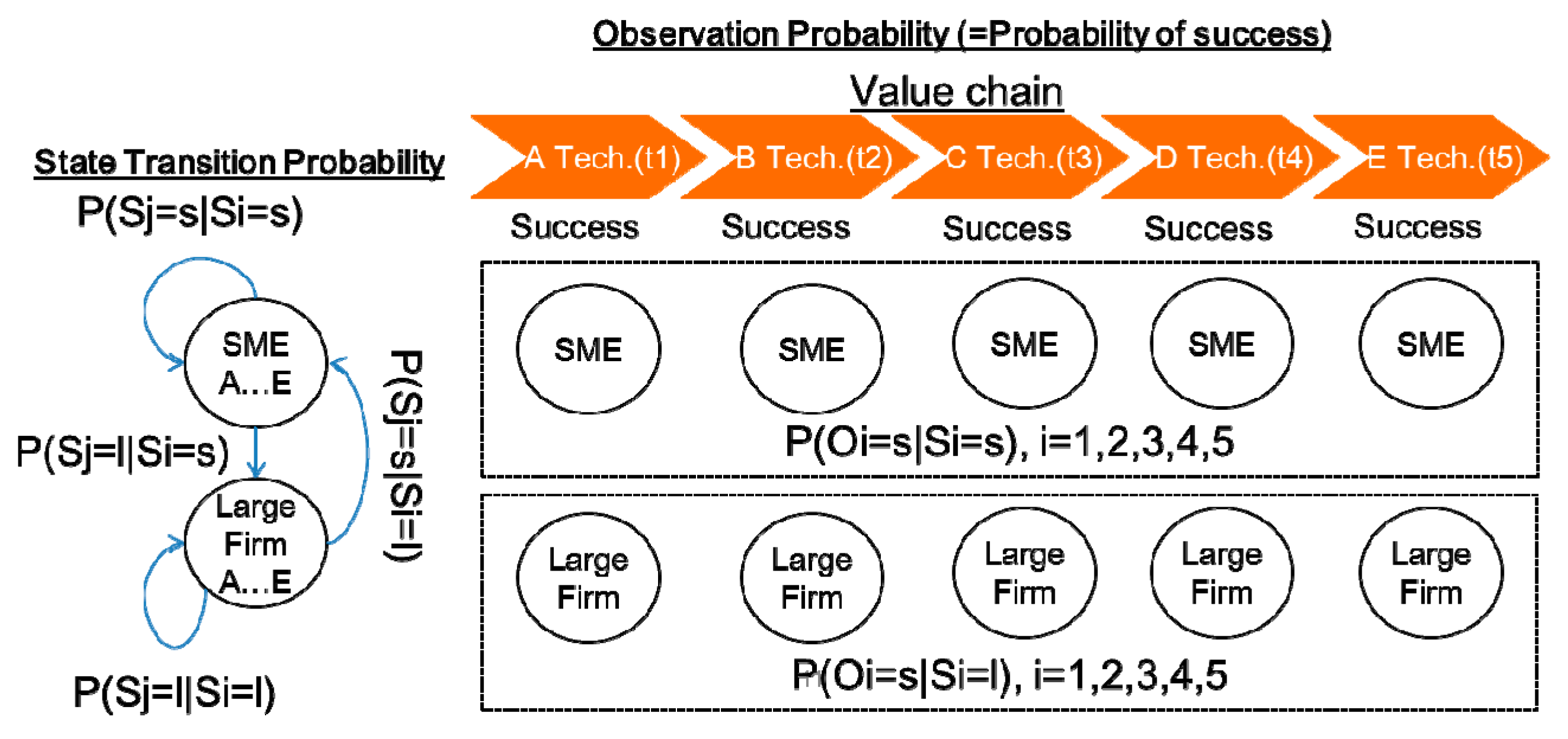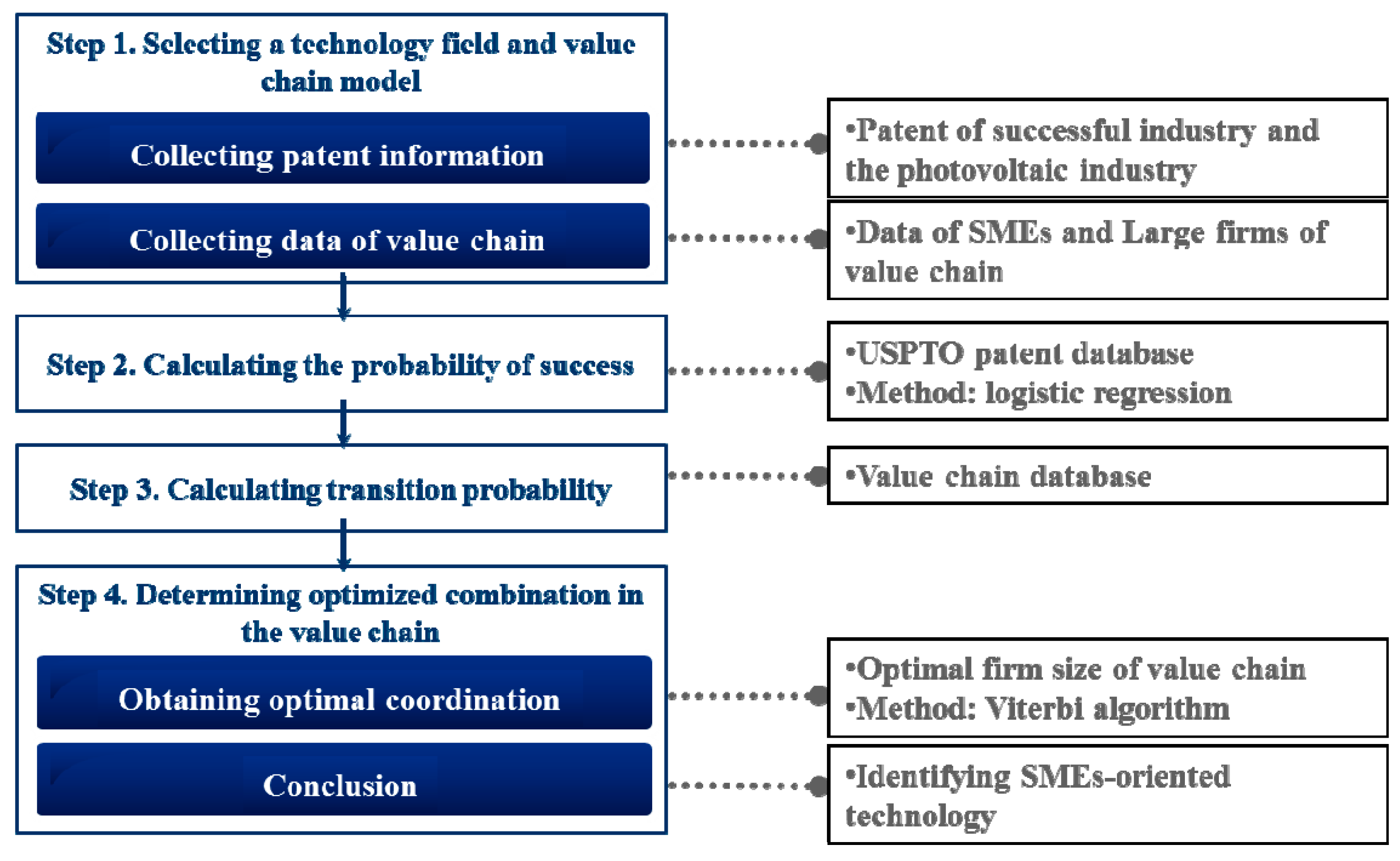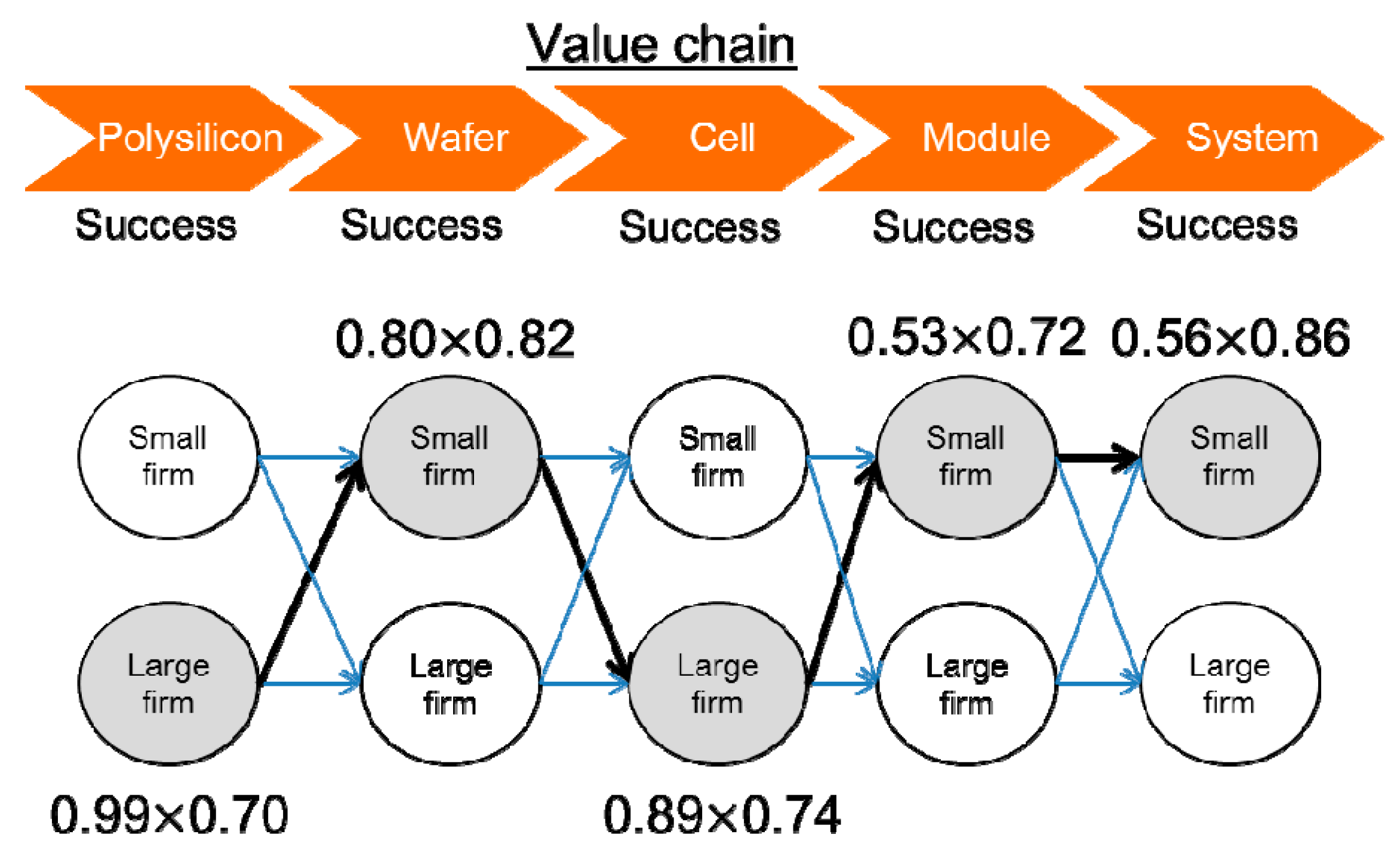Exploring Suitable Technology for Small and Medium-Sized Enterprises (SMEs) Based on a Hidden Markov Model Using Patent Information and Value Chain Analysis
Abstract
:1. Introduction
2. Theoretical Background
2.1. Successful Cooperation between Large Firms and SMEs
2.2. Exploring Technology Fields Appropriate to SMEs
2.3. Patent Bibliographic Information
3. Proposed Approach
3.1. Basic Concepts
3.2. Research Process
3.3. Data
3.4. Methodology
3.5. Processes
3.5.1. Step 1. Selecting a Technology Field and Value Chain Model
3.5.2. Step 2. Calculating the Probability of Success
3.5.3. Step 3. Calculating Transition Probability
3.5.4. Step 4. Determining Optimized Combination in the Value Chain
4. Case Study
4.1. Background
4.2. Step 1. Selecting a Technology Field and Value Chain Model
4.3. Step 2. Calculating the Probability of Success
4.4. Step 3. Calculating Transition Probability
4.5. Step 4. Determining Optimized Combination in the Value Chain
5. Results and Discussion
6. Conclusions
Acknowledgments
Author Contributions
Conflicts of Interest
References
- Smith, H.L.; Dickson, K.; Smith, S.L. “There are two sides to every story”: Innovation and collaboration within networks of large and small firms. Res. Policy 1991, 20, 457–468. [Google Scholar] [CrossRef]
- Woo, C.; Chung, Y.; Chun, D.; Seo, H. Exploring the impact of complementary assets on the environmental performance in manufacturing SMEs. Sustainability 2014, 6, 7412–7432. [Google Scholar] [CrossRef]
- Melin, L. Internationalization as a strategy process. Strateg. Manag. J. 1992, 13, 99–118. [Google Scholar] [CrossRef]
- Dodge, H.R.; Fullerton, S.; Robbins, J.E. Stage of the organizational life cycle and competition as mediators of problem perception for small businesses. Strateg. Manag. J. 1994, 15, 121–134. [Google Scholar] [CrossRef]
- Khurana, A.; Talbot, B. The internationalization process model through the lens of the global color picture tube industry. J. Oper. Manag. 1998, 16, 215–239. [Google Scholar] [CrossRef]
- Falle, S.; Rauter, R.; Engert, S.; Baumgartner, R.J. Sustainability Management with the Sustainability Balanced Scorecard in SMEs: Findings from an Austrian Case Study. Sustainability 2016, 8, 545. [Google Scholar] [CrossRef]
- Gopalakrishnan, S.; Bierly, P.E. The impact of firm size and age on knowledge strategies during product development: A study of the drug delivery industry. IEEE Trans. Eng. Manag. 2006, 53, 3–16. [Google Scholar] [CrossRef]
- Uygun, Ö.; Kahveci, T.C.; Taşkın, H.; Piriştine, B. Readiness assessment model for institutionalization of SMEs using fuzzy hybrid MCDM techniques. Comput. Ind. Eng. 2015, 88, 217–228. [Google Scholar] [CrossRef]
- Owens, J.D. Why do some UK SMEs still find the implementation of a new product development process problematical? An exploratory investigation. Manag. Decis. 2007, 45, 235–251. [Google Scholar] [CrossRef]
- Nieto, M.J.; Santamaría, L. Technological collaboration: Bridging the innovation gap between small and large firms. J. Small Bus. Manag. 2010, 48, 44–69. [Google Scholar] [CrossRef]
- López, J.A.; Assous, M. Michal Kalecki; Palgrave Macmillan: New York, NY, USA, 2010. [Google Scholar]
- Zhu, C.; Liang, L. SME oriented purchasing consortium based on MAS. Proceedings of 2009 International Symposium on Information Engineering and Electronic Commerce, Ternopil, Ukraine, 16–17 May 2009; pp. 808–811. [Google Scholar]
- Hassink, R.; Cooke, P.; Heidenreich, M.; Braczyk, H. Regional innovation support system in South Korea. In Regional Innovation Systems: The Role of Governance in a Globalized World, 2nd ed.; Cooke, P., Heidenreich, M., Braczyk, H.J., Eds.; Routledge: London, UK, 2004; pp. 327–343. [Google Scholar]
- Lee, K.; Park, I.; Go, D.; Yoon, B. Identifying SMEs-Oriented Technology using patent bibliographic information. Proceedings of INFORMS annual meeting: Bridging data and decisions, San Francisco, CA, USA, 9–12 November 2014. [Google Scholar]
- Lee, J. Impact of SME-suitable Business Area Designation on the Korean Tofu Market. KDI Commun. Focus 2015, 62, 1–12. [Google Scholar]
- Park, J.-H.; Lee, B.; Moon, Y.-H.; Kwon, L.-N. Study for selection of industrial areas suitable to small and medium-sized enterprises (SMEs) in Korea. J. Open Innov. Technol. Mark. Complex. 2016, 2, 19. [Google Scholar] [CrossRef]
- Giarratana, M.S. Missing the starting gun: De alio entry order in new markets, inertia and real option capabilities. Eur. Manag. Rev. 2008, 5, 115–124. [Google Scholar] [CrossRef]
- Ahmed, S. Assessing Appropriate Technology for SMEs; DCCI: Washington, DC, USA, 2003. [Google Scholar]
- Sawers, J.L.; Pretorius, M.W.; Oerlemans, L.A. Safeguarding SMEs dynamic capabilities in technology innovative SME-large company partnerships in South Africa. Technovation 2008, 28, 171–182. [Google Scholar] [CrossRef]
- Blind, K.; Mangelsdorf, A. Alliance formation of SMEs: Empirical evidence from standardization committees. IEEE Trans. Eng. Manag. 2013, 60, 148–156. [Google Scholar] [CrossRef]
- Revilla, A.J.; Fernández, Z. The relation between firm size and R&D productivity in different technological regimes. Technovation 2012, 32, 609–623. [Google Scholar]
- Shane, S.; Venkataraman, S. The promise of entrepreneurship as a field of research. Acad. Manag. Rev. 2000, 25, 217–226. [Google Scholar] [CrossRef]
- Holgersson, M. Patent management in entrepreneurial SMEs: A literature review and an empirical study of innovation appropriation, patent propensity, and motives. R&D Manag. 2013, 43, 21–36. [Google Scholar]
- Pérez-Cano, C. Firm size and appropriability of the results of innovation. J. Eng. Technol. Manag. 2013, 30, 209–226. [Google Scholar] [CrossRef]
- Eisenhardt, K.M.; Martin, J.A. Dynamic capabilities: What are they? Strateg. Manag. J. 2000, 1105–1121. [Google Scholar] [CrossRef]
- Teece, D.J. Transactions cost economics and the multinational enterprise An Assessment. J. Econ. Behav. Organ. 1986, 7, 21–45. [Google Scholar] [CrossRef]
- Arranz, N.; de Arroyabe, J.C.F. The choice of partners in R&D cooperation: An empirical analysis of Spanish firms. Technovation 2008, 28, 88–100. [Google Scholar]
- Blomqvist, K.; Hurmelinna, P.; Seppänen, R. Playing the collaboration game right—balancing trust and contracting. Technovation 2005, 25, 497–504. [Google Scholar] [CrossRef]
- Lin, C.-Y.; Ho, Y.-H. Technological innovation for China’s logistics industry. J. Technol. Manag. Innov. 2008, 2, 1–19. [Google Scholar]
- Shi, J.; Li, P. An initial review of policies for SMEs in the US, Japan and China. In Proceedings of the 2006 IEEE International Conference on Management of Innovation & Technology (ICMIT 2006), Singapore, 21–26 June 2006; pp. 270–274. [Google Scholar]
- Puhakka, V. Effects of opportunity discovery strategies of entrepreneurs on performance of new ventures. J. Entrep. 2007, 16, 19–51. [Google Scholar] [CrossRef]
- Cho, C.; Yoon, B.; Coh, B.Y.; Lee, S. An empirical analysis on purposes, drivers and activities of technology opportunity discovery: The case of Korean SMEs in the manufacturing sector. R&D Manag. 2016, 46, 13–35. [Google Scholar]
- Lichtenthaler, E. Technology intelligence processes in leading European and North American multinationals. R&D Manag. 2004, 34, 121–135. [Google Scholar]
- Kassicieh, S.K.; Kirchhoff, B.A.; Walsh, S.T.; McWhorter, P.J. The role of small firms in the transfer of disruptive technologies. Technovation 2002, 22, 667–674. [Google Scholar] [CrossRef]
- Audretsch, D.B.; Vivarelli, M. Firms size and R&D spillovers: Evidence from Italy. Small Bus. Econ. 1996, 8, 249–258. [Google Scholar]
- Oxley, J.E.; Sampson, R.C. The scope and governance of international R&D alliances. Strateg. Manag. J. 2004, 25, 723–749. [Google Scholar]
- Shin, J.; Lee, H. Low-risk opportunity recognition from mature technologies for SMEs. J. Eng. Technol. Manag. 2013, 30, 402–418. [Google Scholar] [CrossRef]
- Yoon, B.; Park, Y. Development of new technology forecasting algorithm: Hybrid approach for morphology analysis and conjoint analysis of patent information. IEEE Trans. Eng. Manag. 2007, 54, 588–599. [Google Scholar] [CrossRef]
- Zhu, D.; Porter, A.L. Automated extraction and visualization of information for technological intelligence and forecasting. Technol. Forecast. Soc. Chang. 2002, 69, 495–506. [Google Scholar] [CrossRef]
- Singh, A.J.; Kasavana, M.L. The impact of information technology on future management of lodging operations: A Delphi study to predict key technological events in 2007 and 2027. Tour. Hosp. Res. 2005, 6, 24–37. [Google Scholar] [CrossRef]
- Yoon, B.; Park, Y. A systematic approach for identifying technology opportunities: Keyword-based morphology analysis. Technol. Forecast. Soc. Chang. 2005, 72, 145–160. [Google Scholar] [CrossRef]
- Yoon, J.; Kim, K. Identifying rapidly evolving technological trends for R&D planning using SAO-based semantic patent networks. Scientometrics 2011, 88, 213–228. [Google Scholar]
- Yoon, J.; Kim, K. Detecting signals of new technological opportunities using semantic patent analysis and outlier detection. Scientometrics 2012, 90, 445–461. [Google Scholar] [CrossRef]
- Daim, T.U.; Rueda, G.; Martin, H.; Gerdsri, P. Forecasting emerging technologies: Use of bibliometrics and patent analysis. Technol. Forecast. Soc. Chang. 2006, 73, 981–1012. [Google Scholar] [CrossRef]
- Yoon, B. On the development of a technology intelligence tool for identifying technology opportunity. Expert Syst. Appl. 2008, 35, 124–135. [Google Scholar] [CrossRef]
- Lee, S.; Mortara, L.; Kerr, C.; Phaal, R.; Probert, D. Corporate document mining for technology intelligence: An analysis of needs, utilisation and possibilities. Int. J. Technol. Intell. Plan. 2011, 7, 110–127. [Google Scholar] [CrossRef]
- Gans, J.S.; Stern, S. The product market and the market for “ideas”: Commercialization strategies for technology entrepreneurs. Res. Policy 2003, 32, 333–350. [Google Scholar] [CrossRef]
- Yoon, B.; Song, B. A systematic approach of partner selection for open innovation. Ind. Manag. Data Syst. 2014, 114, 1068–1093. [Google Scholar] [CrossRef]
- Abbas, A.; Zhang, L.; Khan, S.U. A literature review on the state-of-the-art in patent analysis. World Pat. Inf. 2014, 37, 3–13. [Google Scholar] [CrossRef]
- Seol, H.; Lee, S.; Kim, C. Identifying new business areas using patent information: A DEA and text mining approach. Expert Syst. Appl. 2011, 38, 2933–2941. [Google Scholar] [CrossRef]
- Lee, J.H. Study on the Designating Suitable Industries for SMEs; Sungkyunkwan University: Seoul, Korea, 2016. [Google Scholar]
- Cho, J.; Lee, J. Development of a new technology product evaluation model for assessing commercialization opportunities using Delphi method and fuzzy AHP approach. Expert Syst. Appl. 2013, 40, 5314–5330. [Google Scholar] [CrossRef]
- Tai, A.H.; Ching, W.-K.; Chan, L.-Y. Detection of machine failure: Hidden Markov Model approach. Comput. Ind. Eng. 2009, 57, 608–619. [Google Scholar] [CrossRef]
- Dempster, A.P.; Laird, N.M.; Rubin, D.B. Maximum likelihood from incomplete data via the EM algorithm. J. R. Stat. Soc. Ser. B 1977, 39, 1–38. [Google Scholar]
- SBA. The Small Business Economy; SBA: Washington, DC, USA, 2010. [Google Scholar]
- Porter, M.E.; Millar, V.E. How Information Gives You Competitive Advantage. Harvard Business Review; Reprint Service: Watertown, MA, USA, 1985. [Google Scholar]
- Oh, S.-K.; Ryu, S.-W.; Park, S.-K.; Shin, D.-C.; Kim, Y.-K. Development of Service Use Cases and Business Models for 4G Mobile Communications Based on Device-to-Device Communications. J. Korea Soc. IT Serv. 2012, 11, 339–353. [Google Scholar] [CrossRef]
- Haupt, R.; Kloyer, M.; Lange, M. Patent indicators for the technology life cycle development. Res. Policy 2007, 36, 387–398. [Google Scholar] [CrossRef]
- Harrigan, K.R.; DiGuardo, M.C. Sustainability of Patent-Based Competitive Advantage in the US Communications Services Industry. Available online: https://link.springer.com/article/10.1007/s10961-016-9515-2 (accessed on 1 November 2016).
- Karki, M. Patent citation analysis: A policy analysis tool. World Pat. Inf. 1997, 19, 269–272. [Google Scholar] [CrossRef]
- Breitzman, A.; Thomas, P. Using patent citation analysis to target/value M&A candidates. Res. Technol. Manag. 2002, 45, 28–36. [Google Scholar]
- Kürtössy, J. Innovation indicators derived from patent data. Period. Polytech. Soc. Manag. Sci. 2004, 12, 91. [Google Scholar]
- Deng, Z.; Lev, B.; Narin, F. Science and technology as predictors of stock performance. Financ. Anal. J. 1999, 55, 20–32. [Google Scholar] [CrossRef]
- Kayal, A.A.; Waters, R.C. An empirical evaluation of the technology cycle time indicator as a measure of the pace of technological progress in superconductor technology. IEEE Trans. Eng. Manag. 1999, 46, 127–131. [Google Scholar] [CrossRef]
- McFadyen, M.A.; Cannella, A.A. Social capital and knowledge creation: Diminishing returns of the number and strength of exchange relationships. Acad. Manag. J. 2004, 47, 735–746. [Google Scholar] [CrossRef]







| Variables | Operational Definition |
|---|---|
| Backward citation index (BCI) | BCI = the number of backward citation/the number of patents |
| Current impact index (CII) | CII = sum of annual forward citation X annual number of patents/the number of patents |
| Citations performance ratio (CPR) | CPR = The number of top 20% forward citations/the number of top 20% citation patents |
| Technology cycle time (TCT) | The median age of the patents cited on the front page of a patent document |
| Variable | N | Min. | Max. | Mean | S.D. | 1 | 2 | 3 | 4 | |
|---|---|---|---|---|---|---|---|---|---|---|
| 1 | BCI | 80 | 0.00 | 5.51 | 0.44 | 0.90 | 1 | |||
| 2 | CII | 80 | 1.92 | 60.0 | 27.39 | 16.17 | −0.00 | 1 | ||
| 3 | CPR | 80 | 2.00 | 50.00 | 24.38 | 14.24 | 0.07 | 0.01 | 1 | |
| 4 | TCT | 80 | 8.50 | 24.00 | 14.63 | 5.25 | 0.12 | 0.06 | 0.37 | 1 |
| Variable | Model 1 | Model 2 | ||
|---|---|---|---|---|
| BCI | 10.68 ** | (0.02) | ||
| CII | −0.28 ** | (0.03) | ||
| CRP | 0.25 * | (0.06) | ||
| TCT | 0.78 *** | (0.00) | ||
| R&D size | 0.25 * | (0.09) | −0.02 | (0.12) |
| Age of company | −0.10 *** | (0.00) | −0.0.6 *** | (0.01) |
| Constant | −12.57 | (0.23) | −10.01 *** | (0.00) |
| Number of company | 80 | 80 | ||
| test | 0.00 | 0.00 | ||
| Type | Polysilicon | Wafer | Cell | Module | System |
|---|---|---|---|---|---|
| Small firms | 53% | 82% | 81% | 72% | 86% |
| Large firms | 70% | 81% | 74% | 67% | 87% |
| Type | Polysilicon | Wafer | Cell | Module | System |
|---|---|---|---|---|---|
| Small firms | 1% | 180% | 19% | 122% | 106% |
| Large firms | 99% | 20% | 181% | 78% | 94% |
| Ranking | Polysilicon | Wafer | Cell | Module | System |
|---|---|---|---|---|---|
| No. 1 | Large | Small | Large | Small | Small |
| No. 2 | Large | Small | Large | Large | Large |
| No. 3 | Large | Small | Large | Large | Small |
| No. 4 | Large | Small | Large | Small | Large |
| No. 5 | Large | Large | Large | Small | Small |
© 2017 by the authors. Licensee MDPI, Basel, Switzerland. This article is an open access article distributed under the terms and conditions of the Creative Commons Attribution (CC BY) license (http://creativecommons.org/licenses/by/4.0/).
Share and Cite
Lee, K.; Go, D.; Park, I.; Yoon, B. Exploring Suitable Technology for Small and Medium-Sized Enterprises (SMEs) Based on a Hidden Markov Model Using Patent Information and Value Chain Analysis. Sustainability 2017, 9, 1100. https://doi.org/10.3390/su9071100
Lee K, Go D, Park I, Yoon B. Exploring Suitable Technology for Small and Medium-Sized Enterprises (SMEs) Based on a Hidden Markov Model Using Patent Information and Value Chain Analysis. Sustainability. 2017; 9(7):1100. https://doi.org/10.3390/su9071100
Chicago/Turabian StyleLee, Keeeun, Deaun Go, Inchae Park, and Byungun Yoon. 2017. "Exploring Suitable Technology for Small and Medium-Sized Enterprises (SMEs) Based on a Hidden Markov Model Using Patent Information and Value Chain Analysis" Sustainability 9, no. 7: 1100. https://doi.org/10.3390/su9071100
APA StyleLee, K., Go, D., Park, I., & Yoon, B. (2017). Exploring Suitable Technology for Small and Medium-Sized Enterprises (SMEs) Based on a Hidden Markov Model Using Patent Information and Value Chain Analysis. Sustainability, 9(7), 1100. https://doi.org/10.3390/su9071100






